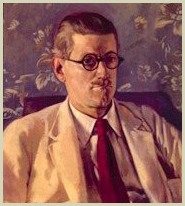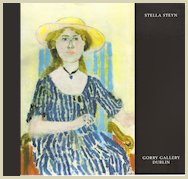

|
Stella Steyn
|
||
|
Illustrations for Finnegans Wake
from Anna Livia Plurabelle by James Joyce
Transition No. 18, Paris 1929
|
||
|
|
||
|
Stella Steyn [1907 - 1987] studied art at the Metropolitan School of Art in Dublin. The noted artist Patrick Tuohy, who had painted a rather famous portrait of Joyce, was not only her teacher but a family friend. Tuohy arranged for Steyn to go to Paris for a year or so to study, and gave her a letter of introduction to Joyce. An aquaintance of her mother's advised against having her daughter meet such a "thorough ruffian", a man "who had written a book no decent person would read--not even his old father." But Steyn's mother felt sure that "Paddy Tuohy, an old friend, would never send [Steyn] to anyone doubtful". Steyn's mother had intended to accompany Steyn in any case, and both Steyn and her mother met with Joyce in 1926. As Steyn was close in age to Joyce's daughter Lucia, Joyce encouraged a friendship between them, and asked Stella Steyn to teach Lucia about art. It was in 1929 that Joyce asked the young Stella Steyn to draw some illustrations for an installment of Anna Livia Plurabelle [Finnegans Wake] to be published in an upcoming issue of Eugene Jolas's transition magazine. Late in her life Steyn wrote an 'Autobiographical Memoir' that was printed in a gallery exhibition catalogue by Gorry Gallery in conjunction with a 1995 retrospective of her work. Though only a few pages long, she succeeds in giving us a sense of these early encounters between the young artist and Joyce and her involvement with the drawings for transition.
from her 'Autobiographical Memoir': "And so we went together to the Square Robiac to present the letter to Joyce. The door was opened by a tall slender man in a white linen jacket, wearing a shade over one eye. He seeemed a little languid and fragile and my mother said she felt sympathy for him at first sight. He asked us into the little salon and told us his wife and his daughter Lucia were out shopping but would soon be back. Then he read Tuohy's letter and looked at the drawings Tuohy had told me to take with me. He took us into the little dining room, which opened with folding doors from the salon, and showed us the portraits Tuohy had painted of his father and himself."
and later:
One late afternoon I had called for Lucia and was sitting waiting for her when he came into the room and, taking no notice of me, he went to the piano and with his head bowed over his hands, accompanying himself, he sang some melancholy Irish songs in a low, sad, voice. I said 'You must miss Ireland'. He replied, 'I do'. I said, 'Would you not like to go back?' He replied, 'No. They jeer too much.'
I agreed to try some illustrations for him for 'Finnegans Wake'. He read passages from the part he suggested to me. I think it was old Ondt's funeral and the rivers of the world holding the train of Anna Livia (the Liffey). I am afraid I understood nothing. He said I had a smattering of a couple of languages and might get something from it, and drew my attention to the musical quality of the language. Today I would have said I understood him, but I am afraid at that age I didn't lie, and so had to admit to him that I did not.
He also tried to explain about meaning on more than one level, and there was something about the chemical contituents of the large egg I afterwards drew to pull in the Earwig's funeral, but I can't remember what it was, exactly, he told me to draw, and why. He expressed himself satisfied, however, and gave me a copy of 'transition', which he signed and dated on one of the pages. He had asked me if there was anything I wanted him to sign for me, but I said 'Oh no thank you', as I had been very embarrased by acquaintances in Dublin sending their copies of 'Dubliners' and Portrait of the Artist' for his signature."
|

|
Portrait of Joyce by Patrick Tuohy, 1924
from the online Centennial Bloomsday exhibit
|

|
Stella Steyn (1907-1987)
A Retrospective View with an Autobiographical Memoir
Exhibition Catalogue, 26 pages
|
|
| |
